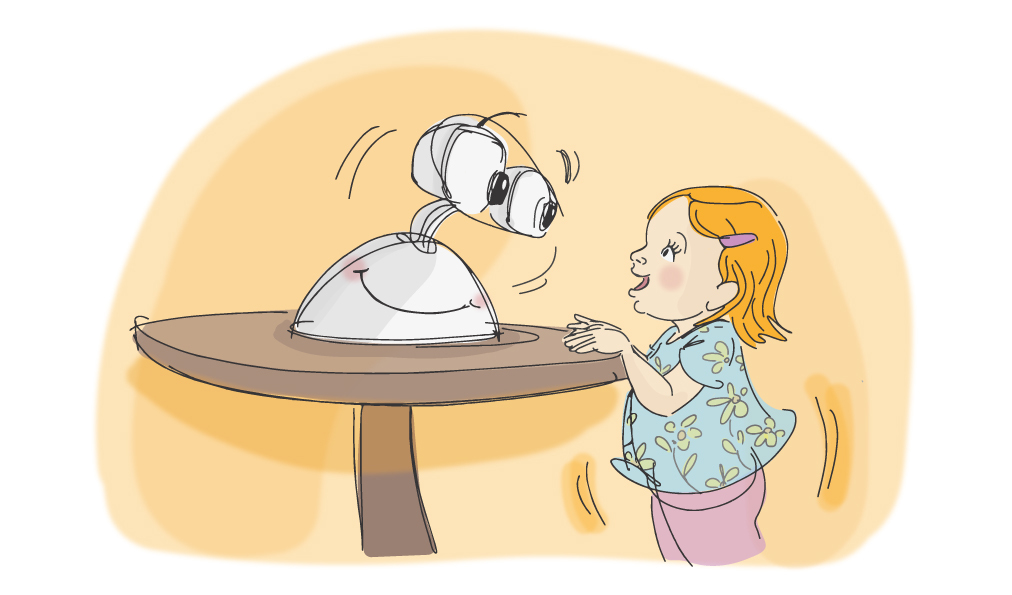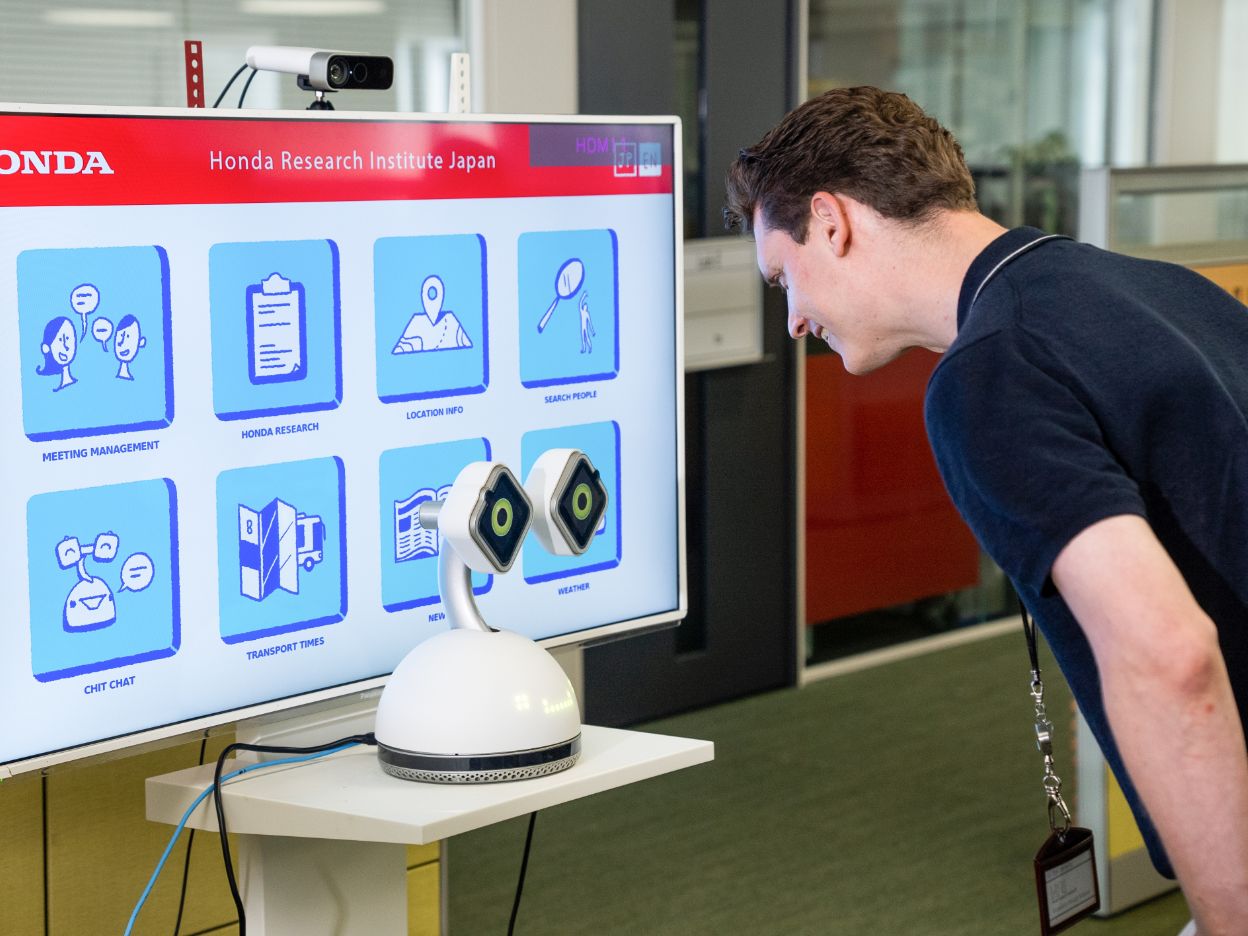Bringing characters to life with distinct personalities for embodied communication Haru the Social Robot
Haru is a new kind of robotic being designed to make people happy. Our goal is to create a robot that makes people smile and fall in love with it, and through its rich, expressive capabilities, to create meaningful connections with people.

Index
Share
Haru’s Purpose
Haru is a new kind of robotic being designed to make people happy. Our goal is to create a robot that makes people smile and fall in love with it, and through its rich, expressive capabilities, to create meaningful connections with people.

Haru’s Inspiration
Haru’s design was inspired by the youthful, energetic characters seen in animated movies. The expressiveness of these characters pluck at the heartstrings of people young and old from across the globe. With Haru, our goal is to take these characters from the silver screen and bring them to life.
Haru is upbeat and enthusiastic. He’s curious about the world around him and eager to learn about humanity. Haru has his own backstory, as well his own hopes and fears. Haru’s antics will entertain, and his adorable animations will build empathy and rapport with the people around him. His expressiveness and happy personality make it easy for people to connect with him.
Haru’s Design
Our approach to designing Haru is based on empathy [1] which began with focusing on empathy, and working with a multidisciplinary team of academics, engineers, artists. and animators to make our dreams a reality. To prime our imagination, we asked real people to act out different emotional states while being sketched. Using these sketches as a basis, Haru’s form began to take shape.
Drawing on the expertise of artists and animators allowed Haru to reinterpret human emotions in his own unique way. And experts in robotics engineering brought these ideas into reality, ensuring that Haru’s design was grounded in the real world. This teamwork resulted in a working prototype of a robot whose unique expressions could be easily understood during interactions with real people.

Haru’s Communication
Haru’s communication abilities mirror our own. By observing how humans communicate, our team of researchers created movements that would allow Haru to express human emotions in his own unique way. Haru can meet the user’s gaze or turn away to express shyness or disapproval. He can lean in to show interest or move backwards when he’s scared. His eyes, mouth, and five degrees of motion all combine to make his emotional state easy to infer, opening the door for humans to form empathetic connections. Moreover, Haru’s nonverbal communication capabilities are not just limited to movement – Haru also has a rich suite of custom sounds that reinforce his gestural expressiveness while fitting his unique personality.

Haru’s Potential
Research and development is still ongoing, but Haru has already shown promise in several areas, such as co-existence with humans through human-robot companionship, new forms of communication, and as a point of collaboration between humans and social robots. Haru’s capacity for empathy would make him an ideal companion [2,3], living and working alongside humans. People already develop deep, long-lasting bonds with non-human beings like pets, and we want to position Haru to be a new kind of companion species.
Haru can also make new means of communication possible. His ability to reinterpret peoples’ expressions enhances both embodied and affective telepresence [4]. His unbounded imagination lets humans exercise their creativity by making stories together [5]. Haru’s unbridled enthusiasm make it a pleasure for humans to stimulate their bodies and minds through interactive gaming [6]. Finally, Haru can act as a platform for embodied communication, enabling all manners of research into social robotics and related issues, such as UNICEF’s efforts to promote ethical AI for children and intergenerational day care for children and elderly (link to partner intergenerational daycare page). In fact, there is already a consortium of interdisciplinary experts in social robotics using Haru as a subject for all manners of social robotics research. Haru’s potential applications, much like Haru’s personality itself, are optimistic and exciting.

Voice


GOMEZ, Randy
HRI-JP provides not only an environment for advanced research but also the opportunity to bring our technology to society by building real systems and taking them from prototype to pilot studies through joint collaboration with global partners.
Related Publications
[1] Haru: Hardware Design of an Experimental Tabletop Robot Assistant.
Randy Gomez, Deborah Szapiro, Kerl Galindo, Keisuke Nakamura.
The 13th Annual ACM/IEEE International Conference on Human Robot Interaction.
[2] Designing "Companion Artifacts": The Relational Construction of Culture and Technology in Social Robotics.
Selma Sabanovic.
Robophilosophy 2020: 3-4.
[3] The Companion Species Manifesto: Dogs, People, and Significant Otherness.
Donna Jeanne Haraway.
Vol. 1. Chicago: Prickly Paradigm Press, 2003.
[4] Emoji to Robomoji: Exploring Affective Telepresence Through Haru.
Randy Gomez, Deborah Szapiro, Luis Merino, Heike Brock, Keisuke Nakamura, Selma Sabanovic.
ICSR 2020: 652-663.
[5] Collaborative Storytelling with Social Robots.
Eric Nichols, Leo Gao, Yurii Vasylkiv, Randy Gomez.
The 2021 IEEE/RSJ International Conference on Intelligent Robots and Systems (IROS 2021).
Best Entertainment and Amusement Paper Award.
[6] Developing a Lightweight Rock-Paper-Scissors Framework for Human-Robot Collaborative Gaming.
Heike Brock, Javier Ponce Chulani, Luis Merino, Deborah Szapiro, Randy Gomez.
IEEE Access 8: 202958-202968 (2020).
